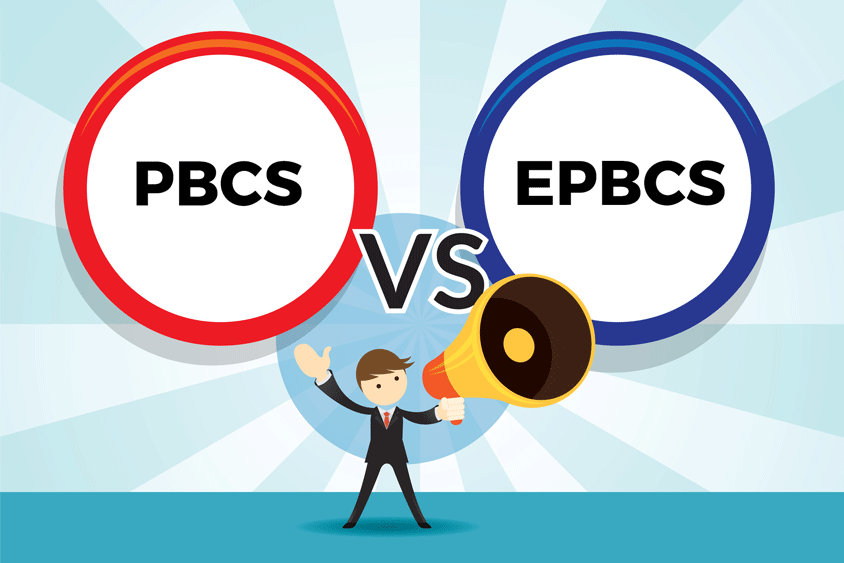Where to Start?
If you’re thinking about migrating or starting new in the Oracle EPM Cloud you have to make a big decision deciding between Oracle Planning and Budgeting Cloud Service (PBCS) or Oracle Enterprise Planning and Budgeting Cloud Service (EPBCS) two of the Oracle EPM cloud modules.
If one of your first questions is what is the Oracle EPM Cloud then we are about to discuss two of its most popular applications so you have come to the right place.
Oracle PBCS is the acronym for the EPM Cloud product also known as Planning Budgeting Cloud Service, which has been recently also sold as NetSuite's Planning and Budgeting Cloud solution. PBCS was the first Oracle EPM product on the cloud and it is an application based on Oracle Hyperion Planning that supports enterprise-wide planning, budgeting, and forecasting in the cloud.
PBCS offers integrations with Microsoft Excel, Word, Outlook, and PowerPoint using the “ Smart View ” plugin for planning and financial reports; this means that users can view planning data forms from within Microsoft Excel.
Both interfaces support ad-hoc analysis of data where row, column, and page dimensions can be pivoted to create different views of the same data. EPBCS is the enterprise equivalent of BPCS and offers additional features and benefits than its rival.
Whether you choose PBCS or EPBCS, the primary benefits of these Oracle EPM cloud applications start with the same premise, cloud hosting: no upfront cost for hardware or software, less IT involvement, and no annual maintenance costs.
In this blog post, will discuss the difference between PBCS and EPBCS of Oracle’s cloud planning applications to help you navigate your options.
If you're looking for an in-depth comparison of PBCS vs. EPBCS, jump straight to the ebook:
Overview
Oracle PBCS was built from on-prem Hyperion Planning, so you’re already getting a proven system. Everything you get with PBCS, you’ll also get with EPBCS. Both applications have the following features:
- 3 BSO Custom Plan Types
- 3 ASO Custom Plan Types
- 1 Consolidated Reporting Cube
Like the on-prem version of Planning, Oracle PBCS allows for flexibility to make changes to business rules and templates behind the business rules. This is where EPBCS departs from on-prem Planning. EPBCS has out-of-the-box frameworks that allow very little custom modification inside plan types. These are the five frameworks found within EPBCS:
- Financial Statement Planning
- Workforce Planning
- Capital Asset Planning
- Project Financial Planning
- Strategic Modeling
Financial Statement Planning
This framework includes four sub-processes that can be enabled one at a time: Revenue, Expense, Balance Sheet, and Cash Flow.
The Financial Statement Planning framework allows users to integrate balance sheets with income statements and cash flow. If you make changes on an income statement, it automatically updates the balance sheet and cash flow. You can also access the framework for revenue/sales and gross margin planning to add dimensions for unique business drivers.
This framework supports direct and indirect cash flow methods. You’re also able to leverage the framework for trend-based planning using best practice expense drivers.
Workforce Planning
This framework attempts to address the needs of HR and Finance, allowing the department to plan by employee, or job code, for compensation-related expenses. Workforce planning can be used enterprise-wide and has the capability to support large organizations spanning the globe.
With this module, you’re able to align your HR strategy with corporate priorities. It’s also a tool for business users to easily keep up with their expenses and benefits.
Capital Asset Planning
This framework allows you to track new and existing assets, as well as intangibles. Capital Asset Planning supports depreciation and amortization calculations, cash flow planning and funding for investment and leased assets, as well as “buy versus lease” comparison. You can use this framework for planning asset-related expenses with automated processes for retirements, transfers, and improvements.
Project Financial Planning
For organizations with many internal projects — such as IT, marketing, R&D, and training — this framework allows for driver-based planning for both short- and long-term projects. This framework lets individual employees drive their project-related planning, while tracking asset-related expenses and project revenues. You also get out-of-the-box analysis to review project performance, project revenue, expenses, and cash flows.
Strategic Modeling
The Strategic Modeling module allows you to get rid of manual and unreliable financial modeling methods. This module can be used for long-term planning, "what-if" modeling, corporate financials, and treasury initiatives. You can simulate various scenarios and stress test various financial models. To learn more about Strategic Modeling, read the blog.
Note: Oracle has made changes to the EPM Cloud structure and pricing. This includes how Planning is set up in the cloud. To learn more, read the blog Oracle EPM Cloud: A New Direction.
Pricing
The prebuilt frameworks are the biggest difference between PBCS and EPBCS, but there’s also a major difference in the price tag. Oracle PBCS is $120 per user per month, while EPBCS is $250 per user per month. For organizations looking for out-of-the-box capabilities, EPBCS is a good fit, but you’ll have to pay a little more. PBCS allows for customization around your specific organization and, though your monthly investment is cheaper, you’ll have to invest time and energy in customizing your environment.
You might also be interested in:
- Video Tour of Oracle PBCS
- PBCS Case Study: Lessons Learned by MV Transportation
- PBCS Project Planning Toolkit
- EPBCS Project Planning Toolkit
- Oracle PBCS Is Still Hyperion Planning (Kscope16)
US-Analytics is a performance management consulting and services firm specializing in today’s leading EPM technologies, including Oracle Hyperion, Orace EPM Cloud, OneStream XF, and more. By modernizing your reporting and forecasting processes, you can free up resources and empower your team to be boardroom advisers.






